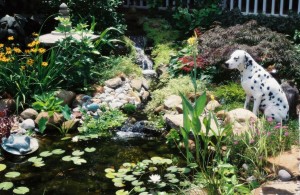Custom Designed Water Gardens: Durham, Greensboro, Raleigh
 Water features are among the fastest growing trends today. Water gardens, waterfalls and streams are beautifying backyards, community areas and commercial businesses across the country. Water features can be virtually any size and fit almost anywhere. From a small townhouse patio water garden, to a long meandering stream, to lovely waterfalls cascading over the rocks into a spacious pond. The size of the pond is designed to complement the existing landscape and can be planned to include other “hard-scapes” such as decks, patios, gazebos and pools. It is amazing how quickly a high maintenance yard can be transformed into a magical, low maintenance water garden.
Water features are among the fastest growing trends today. Water gardens, waterfalls and streams are beautifying backyards, community areas and commercial businesses across the country. Water features can be virtually any size and fit almost anywhere. From a small townhouse patio water garden, to a long meandering stream, to lovely waterfalls cascading over the rocks into a spacious pond. The size of the pond is designed to complement the existing landscape and can be planned to include other “hard-scapes” such as decks, patios, gazebos and pools. It is amazing how quickly a high maintenance yard can be transformed into a magical, low maintenance water garden.
The beauty of water features run much deeper than beautifying the topography of your yard. The most amazing personal transformation will take place as you awake each morning and walk out to your pond — and again, in the evening as the day nears end, the retreat is still there awaiting your arrival. The sights and sounds will welcome you – new plants may have bloomed, the Koi will swim lazily past, and may just wag their tails in hopes of a few tidbits — and a new frog or two may just croak a small “hello.”
Don’t delay in joining the thousands of people who have enhanced their property and their lives with water features. It’s simple to do, and we’re here to help.
Now, let’s talk about the creation of an ecosystem that works directly with nature to create a healthy pond with sparkling clear water. There are no chemicals to add — Remember, the secret is building a balanced ecosystem.
The Aquascape Ecosystem works with Mother Nature, not against her. The easiest way to build a low maintenance water environment is to create a working ecosystem within your water feature.
To achieve a healthy ecosystem, you need the following:
- Mechanical and Biological Filtration – In a closed water feature, you need both a mechanical filter to handle debris and a biological filter to handle the nutrients that feed the water.
- Pump and Plumbing – Re-circulation is essential to add oxygen to the water for fish and bacteria. In addition, re-circulating the water keeps it fresh and allows gases to escape.
- Liner and Underlayment – To maintain zero water loss, an impermeable membrane is mandatory for small water features (under 1,000 sq ft). A strong 45-mil EPDM liner is the best choice for most pond installations. Unlike concrete, it is easy to install and won’t crack. When covered with stone, it has a 40-year life expectancy. A woven needle punched underlayment forms a soft padding for the liner. Unlike newspapers, it is quick to install; unlike sand, it completely covers the vertical areas of the pond shelves; and unlike carpet padding, it allows gases to escape.
- Rocks and Gravel – The most underused elements in a pond ecosystem are rocks and gravel, which should be used to cover your liner completely. Adding rocks and gravel solves many traditional pond problems. Contrary to popular opinion, they reduce pond maintenance by providing surface area for bacteria to colonize. Fish waste and other organic matter that settle to the bottom of the pond are broken down naturally by the bacteria living there, keeping your water clear.
- Plants, Fish and Bacteria – Plants help to clean the pond by removing nutrients from the water for their own nourishment. Fish eat insects and in turn fertilize the plants. Bacteria eat the nutrients that feed green water and therefore keep the water clear.

